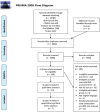Association between skeletal muscle mass and quality of life in adults with cancer: a systematic review and meta-analysis
- PMID: 35156342
- PMCID: PMC8977976
- DOI: 10.1002/jcsm.12928
Association between skeletal muscle mass and quality of life in adults with cancer: a systematic review and meta-analysis
Abstract
Low skeletal muscle mass is known to be associated with poor morbidity and mortality outcomes in cancer, but evidence of its impact on health-related quality of life (HRQOL) is less established. This systematic review and meta-analysis was performed to investigate the relationship between skeletal muscle mass and HRQOL in adults with cancer. Five databases (Ovid MEDLINE, Embase via Ovid, CINAHL plus, Scopus, and PsycInfo) were systematically searched from 1 January 2007 until 2 September 2020. Studies reporting on the association between measures of skeletal muscle (mass and/or radiodensity) derived from analysis of computed tomography imaging, and a validated measure of HRQOL in adults with cancer, were considered for inclusion. Studies classifying skeletal muscle mass as a categorical variable (low or normal) were combined in a meta-analysis to investigate cross-sectional association with HRQOL. Studies reporting skeletal muscle as a continuous variable were qualitatively synthesized. A total of 14 studies involving 2776 participants were eligible for inclusion. Skeletal muscle mass classified as low or normal was used to dichotomize participants in 10 studies (n = 1375). Five different cut points were used for classification across the 10 studies, with low muscle mass attributed to 58% of participants. Low muscle mass was associated with poorer global HRQOL scores [n = 985 from seven studies, standardized mean difference -0.27, 95% confidence interval (CI) -0.40 to -0.14, P < 0.0001], and poorer physical functioning domain HRQOL scores (n = 507 from five studies, standardized mean difference -0.40, 95% CI -0.74 to -0.05, P = 0.02), but not social, role, emotional, or cognitive functioning domain scores (all P > 0.05). Five studies examined the cross-sectional relationship between HRQOL and skeletal muscle mass as a continuous variable and found little evidence of an association unless non-linear analysis was used. Two studies investigated the relationship between longitudinal changes in both skeletal muscle and HRQOL, reporting that an association exists across several HRQOL domains. Low muscle mass may be associated with lower global and physical functioning HRQOL scores in adults with cancer. The interpretation of this relationship is limited by the varied classification of low muscle mass between studies. There is a need for prospective, longitudinal studies examining the interplay between skeletal muscle mass and HRQOL over time, and data should be made accessible to enable reanalysis according to different cut points. Further research is needed to elucidate the causal pathways between these outcomes.
Keywords: Body composition; Computed tomography; EORTC QLQ-C30; FACT; Oncology; Sarcopenia.
© 2022 The Authors. Journal of Cachexia, Sarcopenia and Muscle published by John Wiley & Sons Ltd on behalf of Society on Sarcopenia, Cachexia and Wasting Disorders.
Conflict of interest statement
None declared.
Figures



Similar articles
-
Home treatment for mental health problems: a systematic review.Health Technol Assess. 2001;5(15):1-139. doi: 10.3310/hta5150. Health Technol Assess. 2001. PMID: 11532236
-
Music interventions for improving psychological and physical outcomes in people with cancer.Cochrane Database Syst Rev. 2021 Oct 12;10(10):CD006911. doi: 10.1002/14651858.CD006911.pub4. Cochrane Database Syst Rev. 2021. PMID: 34637527 Free PMC article.
-
Eliciting adverse effects data from participants in clinical trials.Cochrane Database Syst Rev. 2018 Jan 16;1(1):MR000039. doi: 10.1002/14651858.MR000039.pub2. Cochrane Database Syst Rev. 2018. PMID: 29372930 Free PMC article.
-
Self-management interventions for people with chronic obstructive pulmonary disease.Cochrane Database Syst Rev. 2022 Jan 10;1(1):CD002990. doi: 10.1002/14651858.CD002990.pub4. Cochrane Database Syst Rev. 2022. PMID: 35001366 Free PMC article.
-
A systematic review and economic evaluation of epoetin alpha, epoetin beta and darbepoetin alpha in anaemia associated with cancer, especially that attributable to cancer treatment.Health Technol Assess. 2007 Apr;11(13):1-202, iii-iv. doi: 10.3310/hta11130. Health Technol Assess. 2007. PMID: 17408534
Cited by
-
A Cross-Sectional Validation Study of Camry EH101 versus JAMAR Plus Handheld Dynamometers in Colorectal Cancer Patients and Their Correlations with Bioelectrical Impedance and Nutritional Status.Nutrients. 2024 Jun 11;16(12):1824. doi: 10.3390/nu16121824. Nutrients. 2024. PMID: 38931179 Free PMC article.
-
A Cross-Sectional Validation of Horos and CoreSlicer Software Programs for Body Composition Analysis in Abdominal Computed Tomography Scans in Colorectal Cancer Patients.Diagnostics (Basel). 2024 Aug 5;14(15):1696. doi: 10.3390/diagnostics14151696. Diagnostics (Basel). 2024. PMID: 39125572 Free PMC article.
-
A sex-oriented analysis concerning skeletal muscle quantity and quality and associations to quality of life in hospitalized patients with cirrhosis.Health Qual Life Outcomes. 2024 Sep 12;22(1):78. doi: 10.1186/s12955-024-02295-2. Health Qual Life Outcomes. 2024. PMID: 39267044 Free PMC article.
-
Exploring the Association between Health-Related Physical Fitness and Quality of Life in Patients with Cancer: A Cross-Sectional Study.Healthcare (Basel). 2024 Aug 17;12(16):1643. doi: 10.3390/healthcare12161643. Healthcare (Basel). 2024. PMID: 39201201 Free PMC article.
-
Advancing cancer cachexia diagnosis with -omics technology and exercise as molecular medicine.Sports Med Health Sci. 2024 Jan 28;6(1):1-15. doi: 10.1016/j.smhs.2024.01.006. eCollection 2024 Mar. Sports Med Health Sci. 2024. PMID: 38463663 Free PMC article. Review.
References
-
- Martin L, Birdsell L, Macdonald N, Reiman T, Clandinin MT, McCargar LJ, et al. Cancer cachexia in the age of obesity: skeletal muscle depletion is a powerful prognostic factor, independent of body mass index. J Clin Oncol 2013;31:1539–1547. - PubMed
-
- Prado CM, Lieffers JR, McCargar LJ, Reiman T, Sawyer MB, Martin L, et al. Prevalence and clinical implications of sarcopenic obesity in patients with solid tumours of the respiratory and gastrointestinal tracts: a population‐based study. Lancet Oncol 2008;9:629–635. - PubMed
-
- Ninomiya G, Fujii T, Yamada S, Yabusaki N, Suzuki K, Iwata N, et al. Clinical impact of sarcopenia on prognosis in pancreatic ductal adenocarcinoma: a retrospective cohort study. Int J Surg 2017;39:45–51. - PubMed
-
- Shachar SS, Williams GR, Muss HB, Nishijima TF. Prognostic value of sarcopenia in adults with solid tumours: a meta‐analysis and systematic review. Eur J Cancer 2016;57:58–67. - PubMed
Publication types
MeSH terms
Grants and funding
LinkOut - more resources
Full Text Sources
Medical

